
Ants are eusocial insects of the family Formicidae and, along with the related wasps and bees, belong to the order Hymenoptera. Ants evolved from vespoid wasp ancestors in the Cretaceous period. More than 13,800 of an estimated total of 22,000 species have been classified. They are easily identified by their geniculate (elbowed) antennae and the distinctive node-like structure that forms their slender waists.

Formica cunicularia is a species of ant found all over Europe. They are especially common in western Europe and southern England, but they can be found from southern Scandinavia to northern Africa and from Portugal to the Urals. In England, Donisthorpe records the species as having occurred as far north as Bewdley in Worcestershire. In Formica cunicularia, the worker is an ashy grey black color and is usually 4.0–6.5 mm long. The males are found to have a uniformly dark body and are 8.0–9.0 mm long. The queen is yellowish red to dark black and is 7.5–9.0 mm.

Myrmecia is a genus of ants first established by Danish zoologist Johan Christian Fabricius in 1804. The genus is a member of the subfamily Myrmeciinae of the family Formicidae. Myrmecia is a large genus of ants, comprising at least 93 species that are found throughout Australia and its coastal islands, while a single species is only known from New Caledonia. One species has been introduced out of its natural distribution and was found in New Zealand in 1940, but the ant was last seen in 1981. These ants are commonly known as bull ants, bulldog ants or jack jumper ants, and are also associated with many other common names. They are characterized by their extreme aggressiveness, ferocity, and painful stings. Some species are known for the jumping behavior they exhibit when agitated.
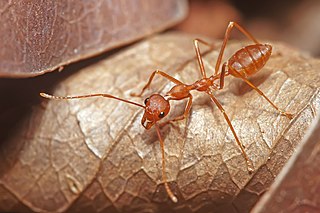
Weaver ants or green ants are eusocial insects of the family Formicidae. Weaver ants live in trees and are known for their unique nest building behaviour where workers construct nests by weaving together leaves using larval silk. Colonies can be extremely large consisting of more than a hundred nests spanning numerous trees and containing more than half a million workers. Like many other ant species, weaver ants prey on small insects and supplement their diet with carbohydrate-rich honeydew excreted by small insects (Hemiptera). Weaver ant workers exhibit a clear bimodal size distribution, with almost no overlap between the size of the minor and major workers. The major workers are approximately 8–10 mm (0.31–0.39 in) in length and the minors approximately half the length of the majors. Major workers forage, defend, maintain, and expand the colony whereas minor workers tend to stay within the nests where they care for the brood and 'milk' scale insects in or close to the nests.

Carpenter ants are large ants indigenous to many forested parts of the world.

Metapleural glands are secretory glands that were considered unique to ants and basal in the evolutionary history of ants. They are responsible for the production of an antibiotic fluid that then collects in a reservoir on the posterior of the ant's alitrunk. These reservoirs are also referred to as the bulla and vary in size between ant species and also between castes of the same species. As of 2023, research has found a metapleural gland convergently evolved in the wasp species Pelecinus polyturator.
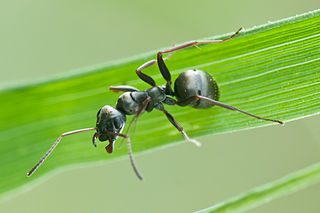
Formica fusca is a black-colored ant commonly found throughout Europe as well as parts of southern Asia and Africa. It has the common names silky ant or dusky ant. The range within the palaearctic region extends from Portugal in the west to Japan in the east and from Italy in the south to Fennoscandia in the north. Populations from North America have been split off as a separate species, Formica subaenescens. F. fusca nests are usually found in rotten tree stumps or under stones in clearcut areas and along woodland borders and hedgerows.

The banded sugar ant, also known as the sugar ant, is a species of ant native to Australia. A member of the genus Camponotus in the subfamily Formicinae, it was described by German entomologist Wilhelm Ferdinand Erichson in 1842. Its common name refers to the ant's liking for sugar and sweet food, as well as the distinctive orange-brown band that wraps around its gaster.

Nothomyrmecia, also known as the dinosaur ant or dawn ant, is an extremely rare genus of ants consisting of a single species, Nothomyrmecia macrops. These ants live in South Australia, nesting in old-growth mallee woodland and Eucalyptus woodland. The full distribution of Nothomyrmecia has never been assessed, and it is unknown how widespread the species truly is; its potential range may be wider if it does favour old-growth mallee woodland. Possible threats to its survival include habitat destruction and climate change. Nothomyrmecia is most active when it is cold because workers encounter fewer competitors and predators such as Camponotus and Iridomyrmex, and it also increases hunting success. Thus, the increase of temperature may prevent them from foraging and very few areas would be suitable for the ant to live in. As a result, the IUCN lists the ant as Critically Endangered.

Rossomyrmex is a genus of slave-making ant in the subfamily Formicinae. The genus consists of four species, each with a single host from the genus Proformica, and has a very wide range of distribution from China to southeastern Spain, from huge extended plains to the top of high mountains.

Formica sanguinea, or blood-red ant, is a species of facultative slave-maker ant in the genus Formica characterized by the ability to secrete formic acid. It ranges from Central and Northern Europe through Russia to Japan, China, the Korean Peninsula, Africa and also the United States. This species is coloured red and black with workers up to 7 mm long.
Colobopsis anderseni, synonym Camponotus anderseni, is a species of mangrove ant found in northern Australia.

Camponotus japonicus, commonly known as the Japanese carpenter ant, is a species of ant native to eastern Asia. It is black, and one of the largest ants. A nest has about ten to thousands of individuals, and it can be a pest when it enters households or protects aphids. There are several subspecies of this ant in different areas of Asia, with the largest of the species being located in northern China.
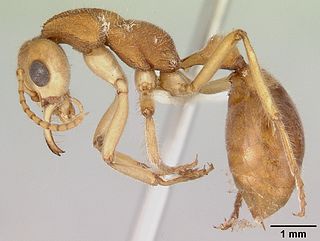
Prionomyrmecini is an ant tribe belonging to the subfamily Myrmeciinae established by William Morton Wheeler in 1915. Two members are a part of this tribe, the extant Nothomyrmecia and the extinct Prionomyrmex. The tribe was once considered a subfamily due to the similarities between Nothomyrmecia and Prionomyrmex, but such reclassification was not widely accepted by the scientific community. These ants can be identified by their long slender bodies, powerful stingers and elongated mandibles. Fossil Prionomyrmecini ants were once found throughout Europe, possibly nesting in trees and preferring jungle habitats. Today, Prionomyrmecini is only found in Australia, preferring old-growth mallee woodland surrounded by Eucalyptus trees. Nothomyrmecia workers feed on nectar and arthropods, using their compound eyes for prey and navigational purposes. Owing to their primitive nature, they do not recruit others to food sources or create pheromone trails. Nothomyrmecia colonies are small, consisting of 50 to 100 individuals.
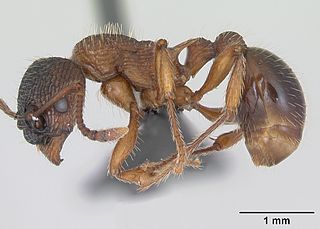
Myrmica schencki is a species of ant in the genus Myrmica.

Slave-making ants or slaver ants are brood parasites that capture broods of other ant species to increase the worker force of their colony. After emerging in the slave-maker nest, slave workers work as if they were in their own colony, while parasite workers only concentrate on replenishing the labor force from neighboring host nests, a process called slave raiding.
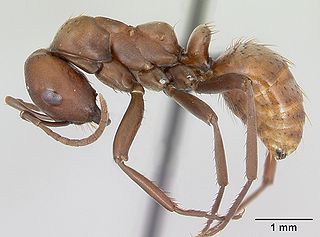
Polyergus rufescens is a species of slave-making ant native to southern Europe and parts of Asia, commonly referred to as the European Amazon ant or as the slave-making ant. It is an obligatory social parasite, unable to feed itself or look after the colony and reliant on ants of another species to undertake these tasks. To replenish these servant ants, it raids nearby ant colonies and carries home pupae and larvae, and these are reared to provide future workers for the colony. A newly mated female P. rufescens needs to make its way into one of these "host" nests, kill the host queen, and be accepted by the host workers in her place.

Symphiles are insects or other organisms which live as welcome guests in the nest of a social insect by which they are fed and guarded. The relationship between the symphile and host may be symbiotic, inquiline or parasitic.
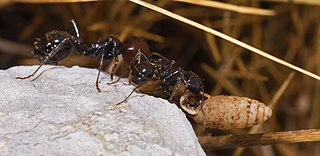
Messor capitatus is an ant species part of the genus Messor. This genus includes about 40 specialized species that are found in dry areas of Mediterranean countries such as Africa, Southern Europe, and Asia.Messor capitatus are known as an Old World species because they release trail pheromones from the Dufour gland instead of from poison glands. Messor capitatus are known as individual foragers that collect food independently of one another but sometimes will also use group foraging to form irregular, broad columns. Messor capitatus main food source is seeds but they also will eat remains of plants and animals.


















